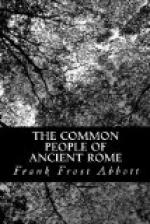It may interest some of the readers of this chapter to look over a few specimens of vulgar Latin from the various periods of its history.
(a) The first one is an extract from the Laws of the Twelve Tables. The original document goes back to the middle of the fifth century B.C., and shows us some of the characteristics of preliterary Latin. The non-periodic form, the omission of pronouns, and the change of subject without warning are especially noticeable.
“Si in ius vocat, ito. Ni it, antestamino, igitur em (=eum) capito. Si calvitur pedemve struit, manum endo iacito (=inicito). Si morbus aevitasve (=aetasve) vitium escit, iumentum dato: si nolet, arceram ne sternito.”
[Illustration:
1 Preliterary Latin. 2 Vulgar Latin 3 Literary Latin 4-8 The Romance languages.
]
(b) This passage from one of Cicero’s letters to his brother (ad Q. fr. 2, 3, 2) may illustrate the familiar conversational style of a gentleman in the first century B.C. It describes an harangue made by the politician Clodius to his partisans.
“Ille furens et exsanguis interrogabat suos in clamore ipso quis esset qui plebem fame necaret. Respondebant operae: ‘Pompeius.’ Quem ire vellent. Respondebant: ‘Crassum.’ Is aderat tum Miloni animo non amico. Hora fere nona quasi signo dato Clodiani nostros consputare coeperunt. Exarsit dolor. Vrgere illi ut loco nos moverent.”
(c) In the following passage, Petronius, 57, one of the freedmen at Trimalchio’s dinner flames out in anger at a fellow-guest whose bearing seems to him supercilious. It shows a great many of the characteristics of vulgar Latin which have been mentioned in this paper. The similarity of its style to that of the preliterary specimen is worth observing. The great number of proverbs and bits of popular wisdom are also noticeable.
“Et nunc spero me sic vivere, ut nemini iocus sim. Homo inter homines sum, capite aperto ambulo; assem aerarium nemini debeo; constitutum habui nunquam; nemo mihi in foro dixit ‘redde, quod debes.’ Glebulas emi, lamelullas paravi; viginti ventres pasco et canem; contubernalem meam redemi, ne quis in sinu illius manus tergeret; mille denarios pro capite solvi; sevir gratis factus sum; spero, sic moriar, ut mortuus non erubescam.”
(d) This short inscription from Pompeii shows some of the peculiarities of popular pronunciation. In ortu we see the same difficulty in knowing when to sound the aspirate which the cockney Englishman has. The silence of the final -m, and the reduction of ae to e are also interesting. Presta mi sinceru (=sincerum): si te amet que (=quae) custodit ortu (=hortum) Venus.
(e) Here follow some of the vulgar forms against which a grammarian, probably of the fourth century, warns his readers. We notice that the popular “mistakes” to which he calls attention are in (1) syncopation and assimilation, in (2) the use of the diminutive for the primitive, and pronouncing au as o, in (3) the same reduction of ct to t (or tt) which we find in such Romance forms as Ottobre, in (4) the aspirate falsely added, in (5) syncopation and the confusion of v and b, and in (6) the silence of final -m.




